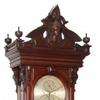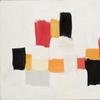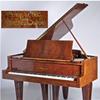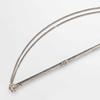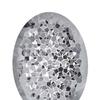Getty Acquires Important Concrete Poems
- LOS ANGELES, California
- /
- March 07, 2017
The Getty Research Institute (GRI) announced today the acquisition of a suite of prints, a folded paper poem, and an artist’s book by the Scottish artist and poet Ian Hamilton Finlay, as well as a 3D “cubepoem” by the Brazilian artist and poet Augusto de Campos. The poems will be among the more than 100 works featured in the upcoming exhibition Concrete Poetry: Words and Sounds in Graphic Space, on view at the Getty Research Institute from March 28 through July 30, 2017. The exhibition explores the foundational decades of concrete poetry, a major postwar international movement that treated language as a visual and spatial construct.
“The Getty Research Institute has exceptionally strong holdings in visual and sound poetry. It is a fertile area of research that intersects with our collections of artists’ books, prints, and postwar archives,” said Thomas W. Gaehtgens, director of the Getty Research Institute. “We are delighted to continue to add to these collections with the acquisition of important works by Ian Hamilton Finlay and Augusto de Campos. Additionally, we’re thrilled to give our audiences the opportunity to experience these poems in person, and in context, in the upcoming concrete poetry exhibition.”
Ian Hamilton Finlay
Ian Hamilton Finlay (Scottish, 1925-2006) was an experimental poet and artist who is best known for his celebrated Little Sparta, a garden outside of Edinburgh comprising a landscape of poetry inscribed on wood and stone. This self-described “AVANTE-GARDEner” was one of the world’s leading proponents of concrete poetry. In the 1960s, Finlay developed an approach to poetry that, while unique, shared affinities with the minimalist verbal language and spatial structures of the Swiss poet Eugen Gomringer and the Brazilian poets Haroldo and Augusto de Campos.
From the 1960s until his death, Finlay collaborated with graphic designers and visual artists to make distinctive printed poems that creatively employ color, scale, and typography. He also published his own works and those of other concrete poets.
The Blue and the Brown Poems consists of 12 concrete poems by Finlay that were originally published as a large folio calendar in 1968. The title refers to the philosopher Ludwig Wittgenstein’s Blue and Brown Books (1958), in which Wittgenstein developed the concept that the meaning of a word is its actual use in language. Finlay’s suite focuses on the look and sound of words we think we know and therefore take for granted. For example, Ho/Horizon/On forms a pyramid enclosing new words, “no,” “oh,” and “ho ho,” which gradually overwhelm the visibility of the word “horizon.”
Finlay’s poems often featured nautical themes. The newly acquired 4 Sails from 1968 is a folded work printed on bright yellow paper that evokes the shape of boat sails. The poem consists of four mysterious lines: roSY fAr blacK / patcheD BroKen fAded / lucKY fULI / GreeN FainteR LoatH. The strategic use of capital letters refers to the registration letters of ports in Scotland (for example, “A” for Aberdeen). This three-dimensional work joins the red and blue versions of 4 Sails already in the GRI’s collection.
Poem with 3 Stripes, ca. 1963, is a little-known collage booklet that may mark the first instance of Finlay’s use of the tugboat theme in his concrete poetry. He noted that he preferred tugboats over fishing boats because of their cheery “toot” sound. Personification, in this case, of the tugboat, runs throughout Finlay’s poetry.
Augusto de Campos
Along with his brother Haroldo de Campos (Brazilian, 1925-2003) and his friend Décio Pignatari (Brazilian, 1927-2012), Augusto de Campos (Brazilian, b. 1931) founded the literary magazine Noigandres and was, like Finlay, central to the international community of concrete poets. Working independently, Finlay and Augusto became aware of one another’s poetry in the early 1960s. corresponded, and were known to share a mutual admiration. In later years, Finlay focused on his garden, while Augusto produced digital animations of his poetry by projecting verbal, visual, and sonic components on walls and screens.
Linguaviagema monumental cubepoem measuring 25 x 25.5 x 25.5 cm, was created in 1967 for the international Brighton Festival, which featured an exhibition of concrete poetry. Three letters appear on each face of the cube: LIN / GUA / VIA / GEM. In assembling and exploring the work inside and out, the viewer encounters the words linguagem (language), viagem (voyage), lingua (tongue), and via (via). Augusto returned to Linguaviagem, transforming it in scale, color and font.
“Though separated by an ocean, these two exceptional poets shared a strong artistic point of view and were pioneers in combining words, sounds, and graphic elements in surprising ways,” said Nancy Perloff, curator, modern & contemporary collections at the Getty Research Institute. “Ian Hamilton Finlay and Augusto de Campos stand out as masters of their form and I’m pleased to add more of their distinctive work to the GRI collections, as well as share it with our audiences. I had the opportunity to meet Augusto during a major retrospective of his work in São Paulo in July 2016 and to exchange fascinating information with him about his use of colored fonts, neologisms, visual-vocal symbols, and digital poetics.”
Works by Ian Hamilton Finlay, Augusto de Campos, Henri Chopin, Ernst Jandl, Mary Ellen Solt, Emmett Williams, and others will be on view in Concrete Poetry: Words and Sounds in Graphic Space at the Getty Research Institute March 28 through July 30, 2017. Drawn principally from the Getty Research Institute's collection of prints, artists' books, journals, and manuscripts documenting the international concrete poetry movement, this exhibition focuses on the visual, verbal, and sonic experiments of the 1950s, '60s, and '70s. Concrete Poetry explores how poets invented new forms such as poster poems and standing poems and continuously re-created their projects across media.


